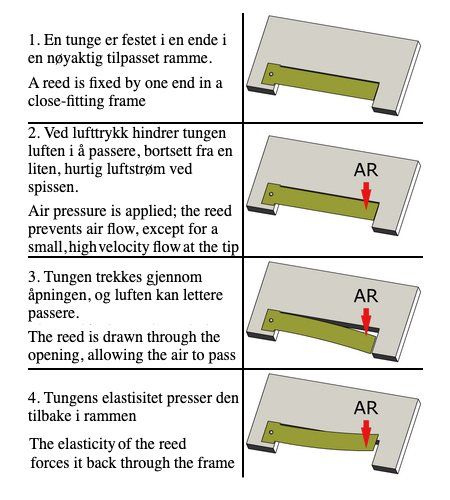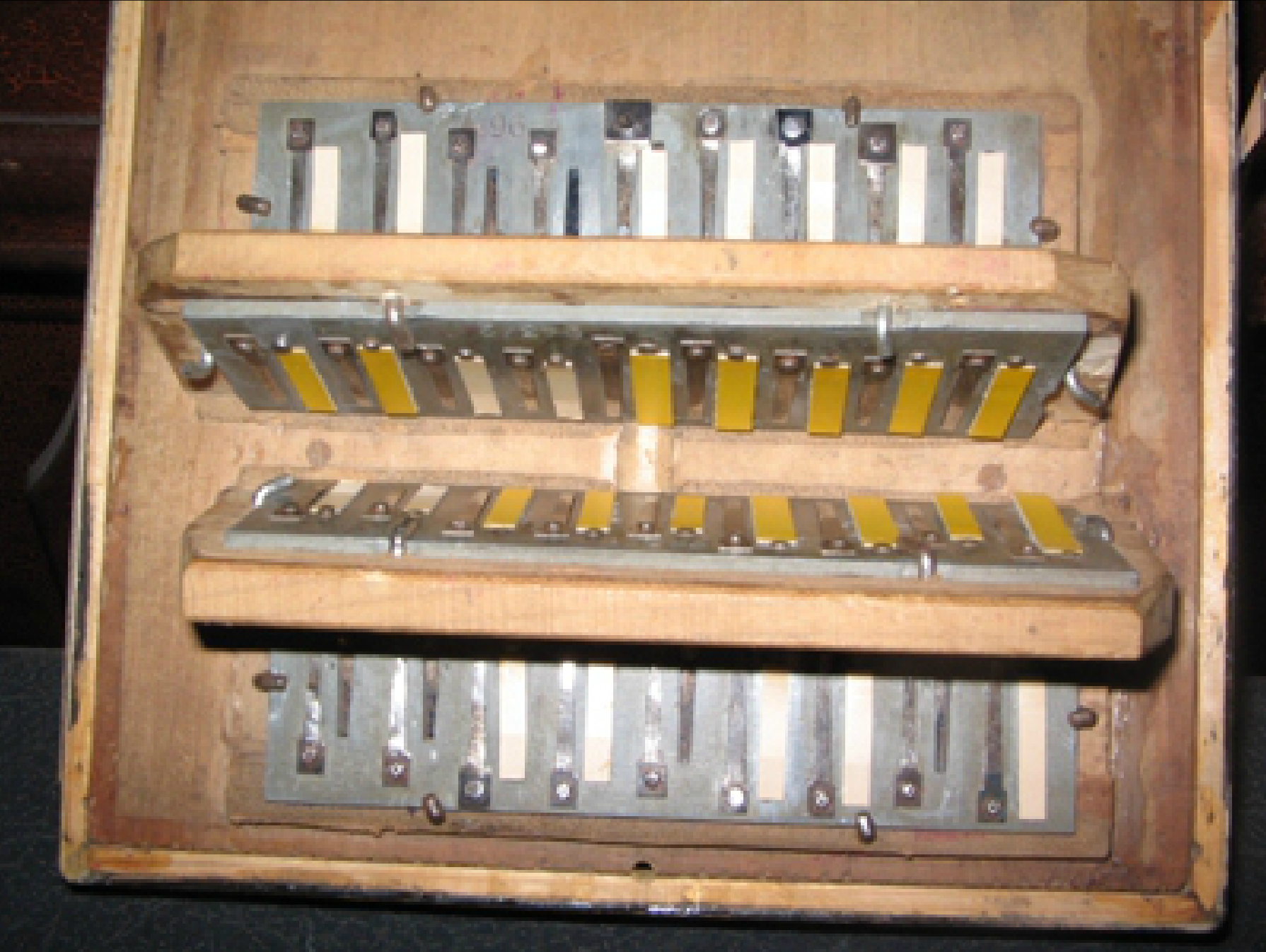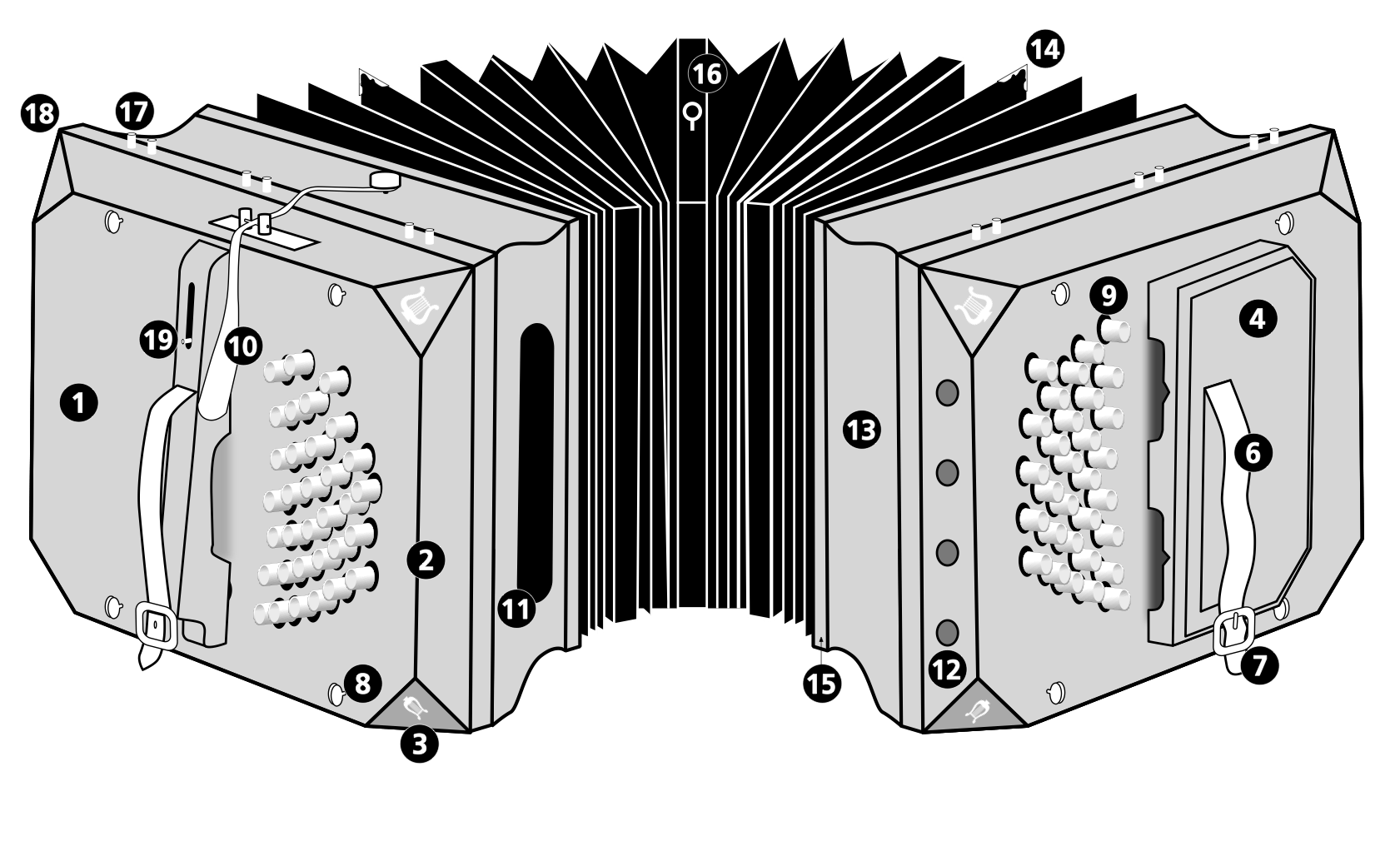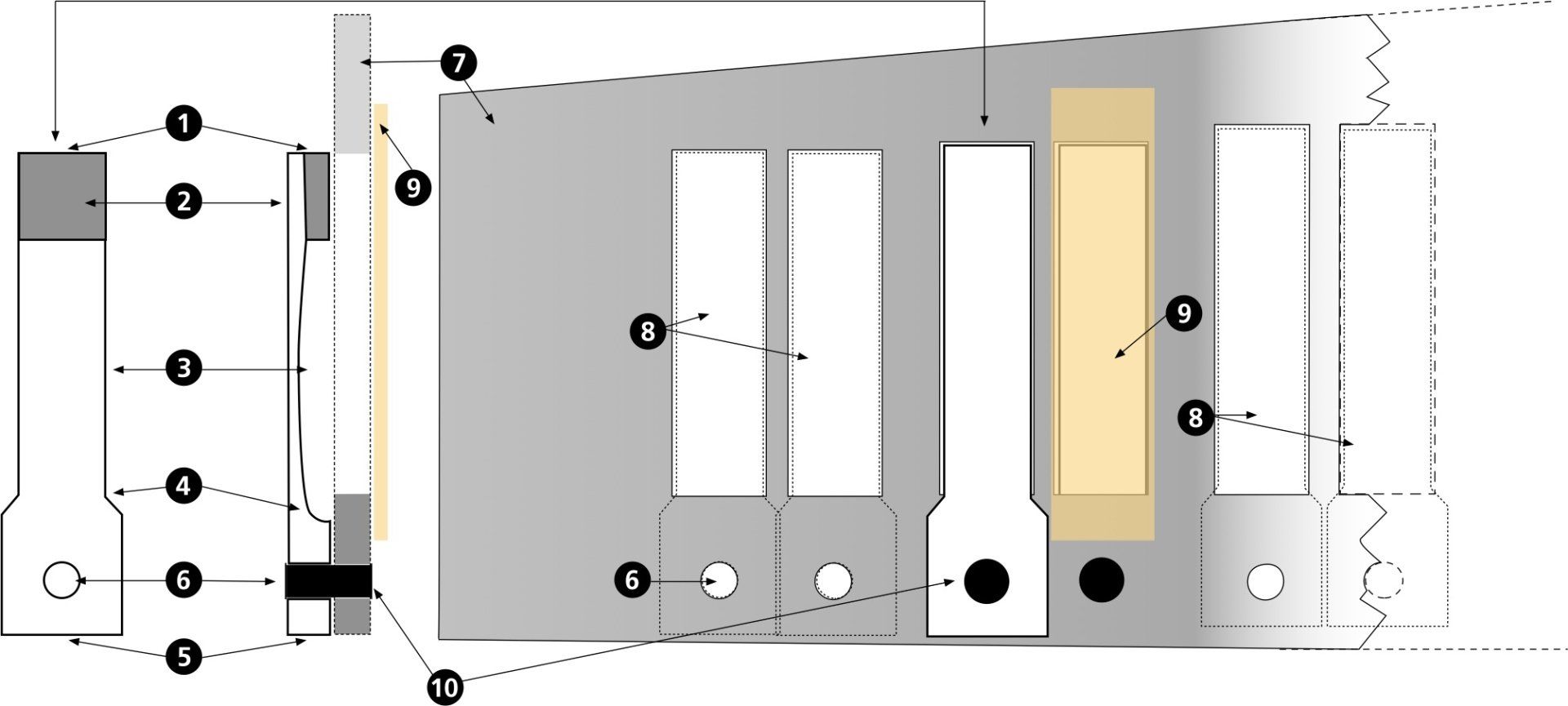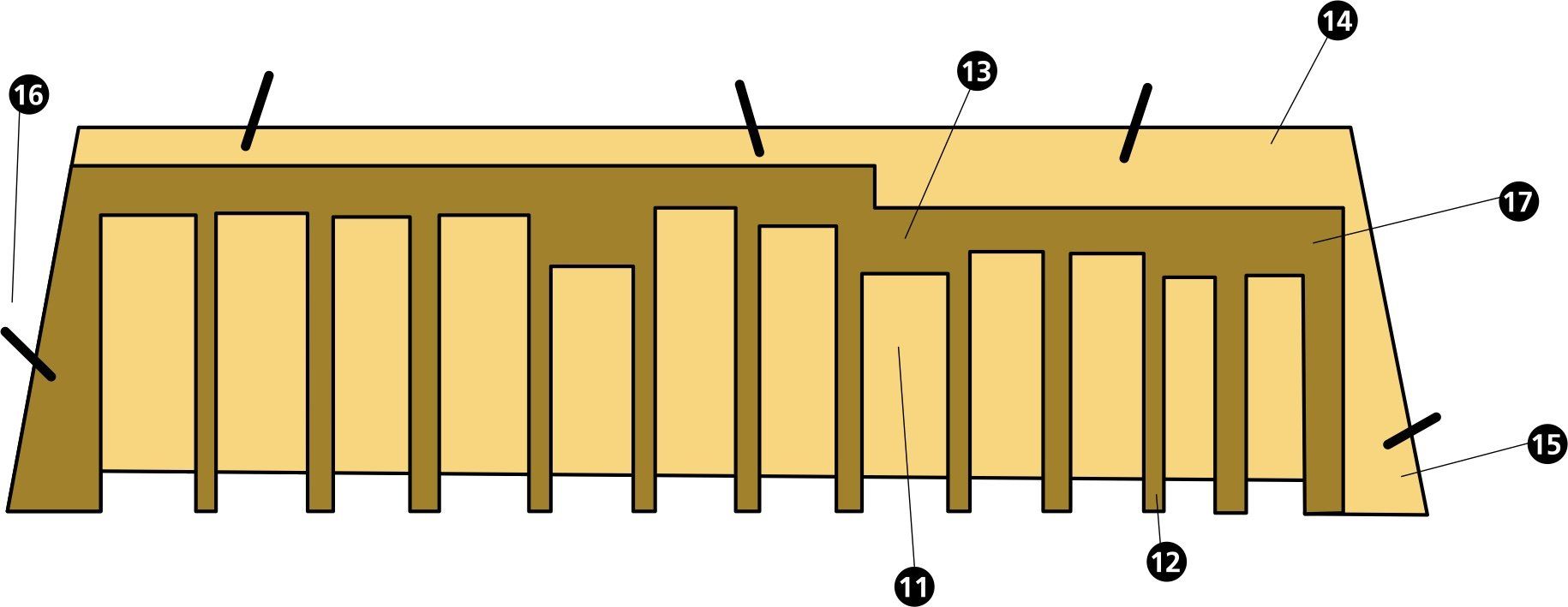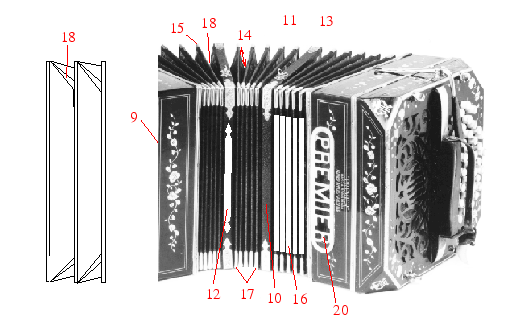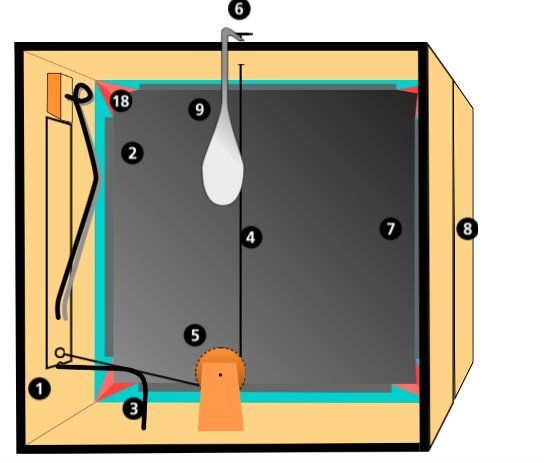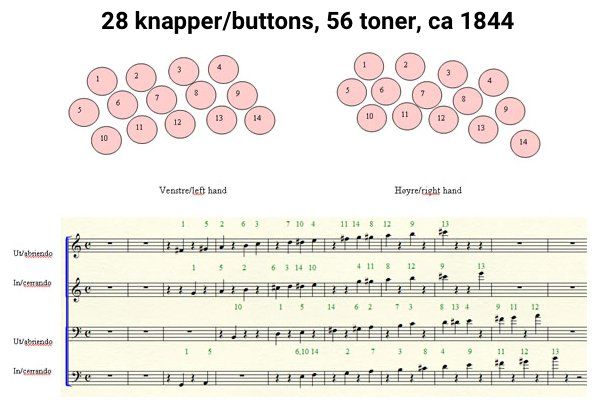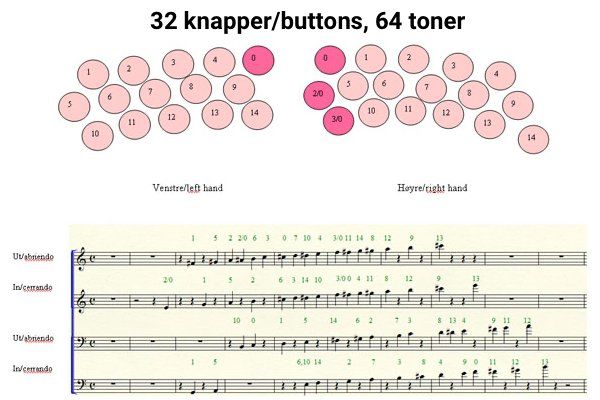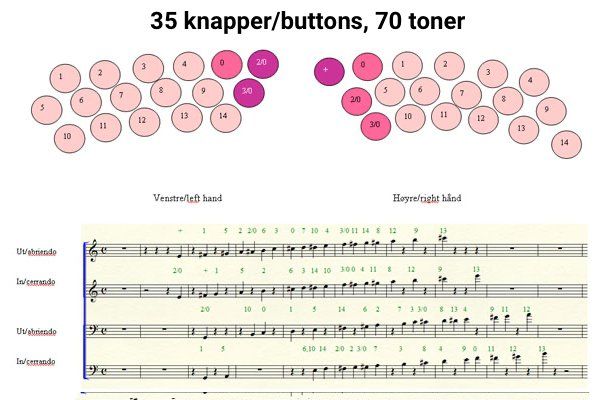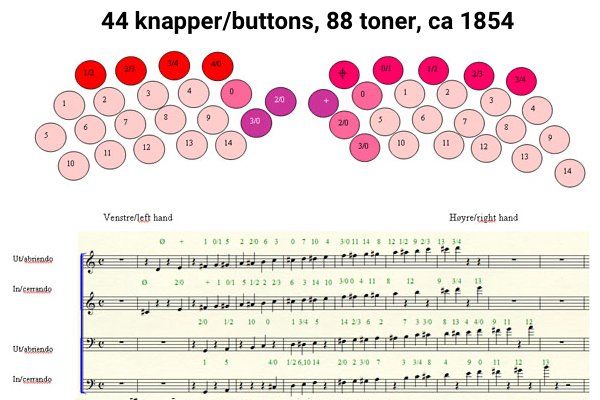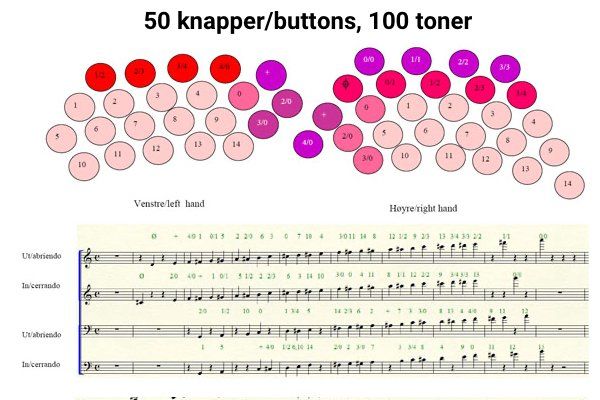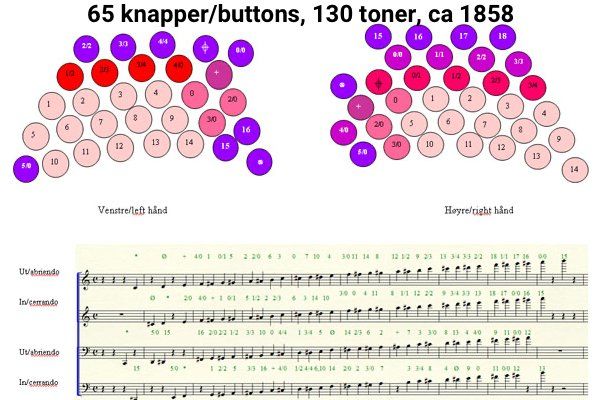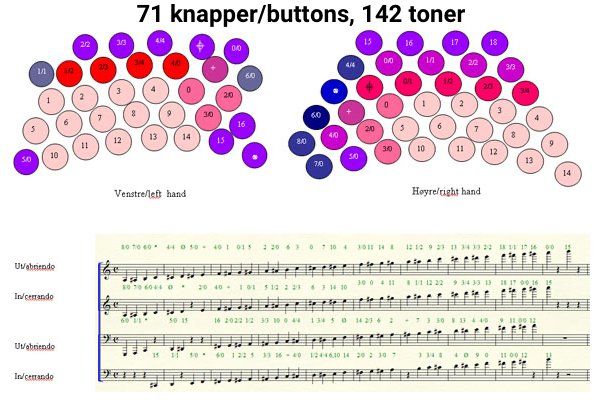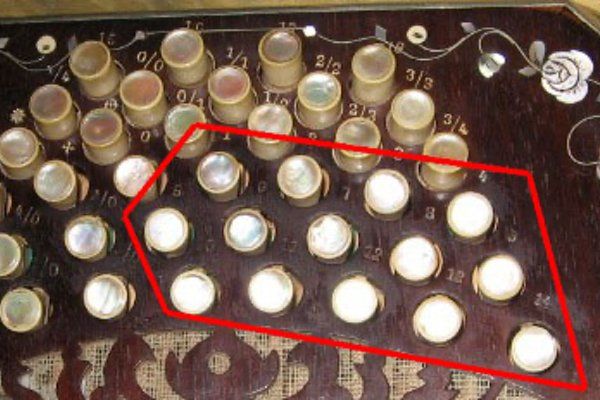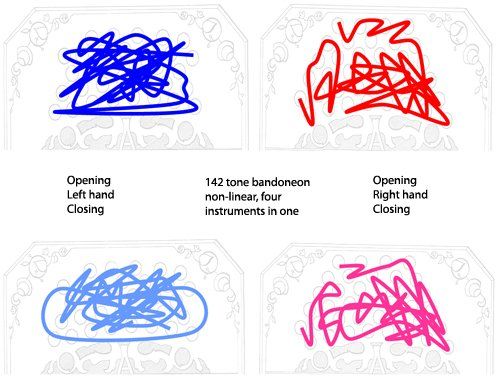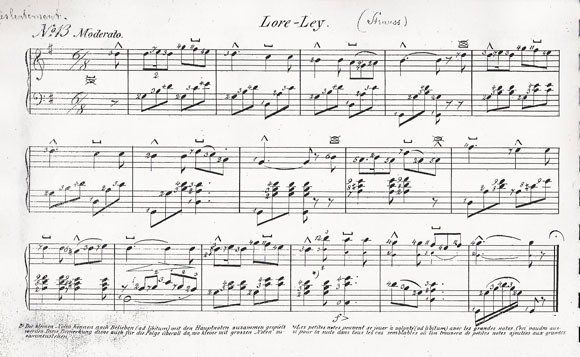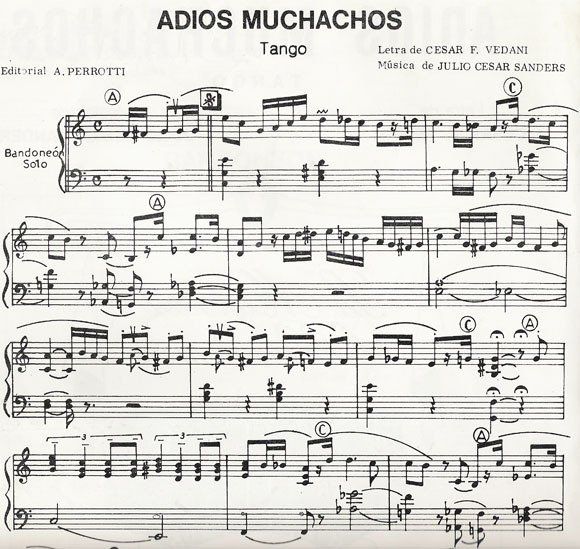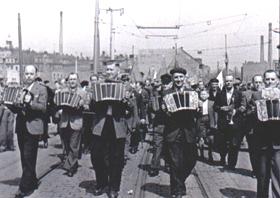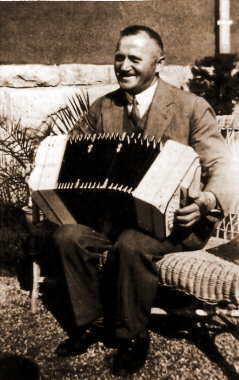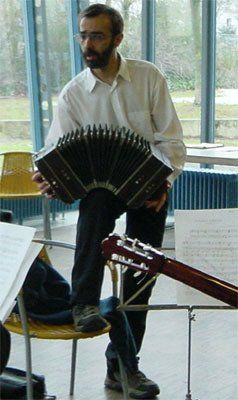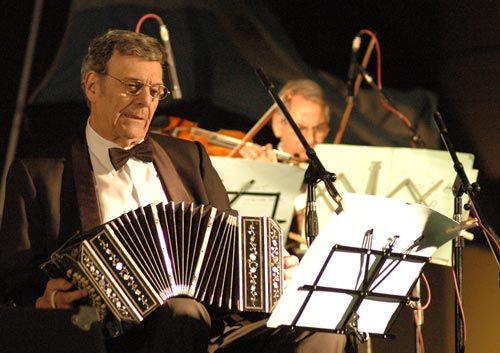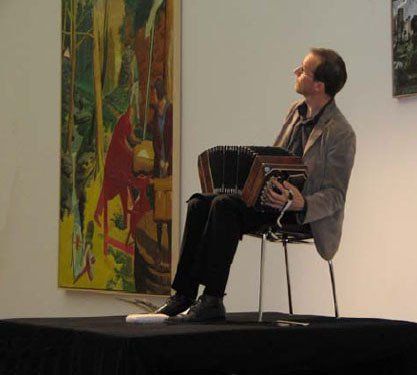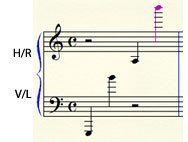Bandoneonets utvikling fra avansert trerader med 56 toner til fire selvstendige fullt kromatiske instrumenter (to i venstre hånd og to i høyre) med 142 toner eller mer som spenner over mer enn fem oktaver.

This website is best viewed on a desk top or lap top computer. Some images will not adjust to the mobile screen.
Free-reed instruments
There are many reed instruments. Some are single-reed instruments (clarinet and saxophone) and some are double-reed instruments (oboe, cor Anglais, bassoon and contrabassoon) which have reeds made from a thin strip of cane. Church organs have reeds too but made of metal. The tones of both types of instruments are produced by a current of air -- either from the player's lungs or from bellows -- which strikes the reeds and causes them to vibrate. Yet none of these reeds are free-reeds; they are beating-reeds, that is, the reeds strike against another object to produce the sound. The free-reeds do not strike against anything while vibrating. It is called 'free' because it has an elastic tongue which vibrates freely within a frame.
Message from editor [If this text is showing in a pop-up, press the escape key.]
Free reed aerophone is a musical instrument where sound is produced as air flows past a vibrating reed in a frame. Higher or lower air pressure is generated by blowing or sucking, or with opening or closing the bellows.
The following illustrations depict the type of reeds typical of harmonicas, accordions and reed organs as it goes through a cycle of vibration. One side of the reed frame is omitted from the images for clarity; in actuality, the frame surrounds the reed on four sides.
Each time the reed passes through the frame, it interrupts air flow. These rapid, periodic interruptions of the air flow initiate the audible vibrations perceived by the listener. In a free-reed instrument, it is the physical characteristics of the reed itself, such as mass, length, cross-sectional area and stiffness that primarily determine the pitch (frequency) of the musical note produced. Of secondary importance to the pitch are the physical dimensions of the chamber in which the reed is fitted, and of the air flow.
In order to generate tones both by expanding and compressing the bellows, free-reeds usually have double sets of reeds with one-way valves.
Reed board from bandoneon, circa 1940. Dual voice 4’ + 8’, tuned in octaves with trapezoid steel reeds (like ordinary accordions) riveted to common zinc plates.
Keyboard mechanics in a two-voiced bandoneon
Animation by Steve Morrall
The anatomy of the bandoneon
Click + to expand captions list in your language
- Captions in English
1 Lid
2 Side
3 Cut corner with lyra
4 Bass case
5 Handle
6 Strap
7 Handle buckle
8 Lid Screw L
9 Buttons
10 Air valve handle
11 Air valve grating
12 Sound hole ring
13 Bellows frame
14 Bellows corner
15 Moulding
16 Eyelet
17 Register button
18 Register frame
19 Thumb switch
- Bildetekster Norsk
1 Lokk
2 Side
3 Avkuttet hjørne med lyre
4 Basskasse
5 Håndtak
6 Håndrem
7 Håndremspenne
8 okkskrue
9 Knapper
10 Spjeldhåndtak
11 Spjeldskilt
12 Lydhullring
13 Belgramme
14 Belghjørne
15 Pyntelist
16 Belgøye
17 Registerknapp
18 Registerramme
19 Tommelbryter
- Bildunterschriften Deutsch
1 Gehäusedecke
2 Gehäuserhmen
3 verbrochene Ecke. Lyrecke
4 Brummkästchen
5 Griff, Griffhelm
6 Handriemen
7 Riemenschnalle
8 Flügelschraube
9 Taste
10 Lufthebel mir Achse
11 Balgkappenschild
12 Schallring
13 Balgrahmen
14 Stradellaecke
15 Fassonleiste
16 Tragöse
17 Registerknopf
18 Registerrahmen
19 Daumenscheiber
- Subtítulos Castellano
1 tapa
2 marco de caja
3 ochava con la lira
4 caja de resonancia
5 empuñadura, manija
6 correa
7 hebilla
8 palomita
9 tecla
10 palanca de válvula
11 careta de válvula
12 orificio acústico
13 marco de fuelle
14 esquinero de fuelle
15 filete de adorno
16 corchete
17 moldura, varilla de cuarta caña
- Légendes Français
1 couvercle ajouré
2 -
3 coin chanfreiné avec lyre incrusté
4 caisse de résonance
5 repose main
6 lanière
7 boucle
8 visse d’assemblage
9 touche
10 levier de soupape
11 enjoliveur
12 -
13 cadre de soufflet
14 coin en maillechort
15 garniture métallique
16 crochet en collerette
17 listel profilé
Click + to expand captions list in your language
- Subtítulos Castellano
1 tête de l'anche
2 masselote
3 bordure de l'anche
4 pied de l'anche
5 -
6 trou à riveter
7 Plaque
8 fenêtre de vibration
9 Peau
10 rivet à tête
11 chambre
12 cloison
13 fond de la chambre
14 sommier
15 pied de sommier
16 piton à vis
17 joint d'étanch'eit'e
18 table d'harmonie
19 Évent
20 trou de centrage et fixation
- Bildetekster Norsk
1 tungeespiss
2 tungevekt
3 tungekant
4 tungerot
5 tungefeste
6 naglehull
7 tungeerekke
8 tungeespalte
9 tungeventil
10 nagle med hode
11 toneestokkskille
12 skillevegg
13 tungerekkebase
14 toneestokk
15 toneestokkfløy
16 festeskruer for tonestokk
17 toneestokkpakning (skinn)
18 tonebrett
19 tonehull
20 toneestokkfeste
- Captions in English
1 reed head
2 reed weight
3 flank
4 reed foot
5 -
6 rivet hole
7 reed board
8 vibration channel
9 leather lamella
10 rivet with head
11 chamber wall
12 chamber separator
13 chamber pier
14 pier back
15 chamber frame
16 hook
17 leather gasket
18 mounting board
19 vent, sound duct
20 chamber frame screw
- Bildunterschriften Deutsch
1 Zungenkopf
2 Zungengewicht
3 Flanke
4 Zungenfuss
5 Zungenstiefel
6 Nietloch
7 Platine
8 Schwingungskanal
9 Zungenleder
10 Nietstift mit Nietkopf
11 Kanzellenwand
12 Kanzellensteg
13 Kanzellendamm
14 Stimmstockrücken
15 Kanzellenrahmen
16 Hakenschraube
17 Dichtungsleder
18 Montierboden
19 Tonloch
20 Kanzellenrahmenschraube
- Légendes Français
1 couvercle ajouré
2 -
3 coin chanfreiné avec lyre incrusté
4 caisse de résonance
5 repose main
6 lanière
7 boucle
8 visse d’assemblage
9 touche
10 levier de soupape
11 enjoliveur
12 -
13 cadre de soufflet
14 coin en maillechort
15 garniture métallique
16 crochet en collerette
17 listel profilé
Tonekammerarrangement - Tone chamber arrangement
Animation by Steve Morrall
11 Tonekammerbunn
14 Tonestokkrygg
18 Monteringsplate
19 Tonehull
11 Reed chamber bottom
14 Reed block back
18 Mounting board
19 Tone hole
11 Kanzellenwand
14 Stimmstockkrücken
18 Montierboden
19 Tonlock
- Subtítulos Castellano
1 tapa de válvula con anclaje y articulación
2 muelle de valvula
3 guia de valvula
4 cordón
5 roldana
6 alambre de válvula
7 forro de pliegue
8 junta de tapa
9 marco de fuelle
10 marquito central
11 esquinero central
12 chapa de adorno de marquito central
13 pitón
14 profundidad de pliegue
15 altura de pliegue
16 varilla de pliegue
17 esquinero de fuelle
18 badana de esquinero
19 pliegue de fuelle
20 careta de valvula
- Bildetekster Norsk
1 luftspjell med feste og lærhengsel
2 Luftspjellfjær
3 Posisjonsstag
4 Spjellsnor
5 Spjelltrinse
6 spjelldrager med hode
7 belgbrettforsterkning
8 belgrammepakning (lær)
9 Belgramme
10 Midtramme
11 Midtrammehjørnebeslag
12 Midtrammepynt
13 festeøye for bærerem
14 Belgfoldbunn
15 Belgfoldtopp
16 Belgfoldskåner
17 Belghjørnebeslag
18 belghjørnefold (lær)
19 Foldeside
20 Luftspjellskilt
- Captions in English
1 "main valve with attachment and leather articulation"
2 valve spring
3 valve guide
4 cord
5 roller
6 needle with head
7
8 bellow gasket
9 bellow frame
10 central frame
11 central frame corner piece
12 central frame edging
13 eyelet
14 fold depth
15 fold height
16 fold edging
17 corner pieces
18 bellow corner leather
19 fold side
20 valve plaque
- Bildunterschriften Deutsch
1 Balgklappe mit Klappenfuss und Ledergelenk
2 Balgklappenfeder
3 Führungsstift
4 Zugschnur
5 Schnurrädchen
6 Nadel mit Kopf
7 Bruchkantenüberzug
8 Balgrahmendichtung
9 Balgrahmen
10 Mitteltrahmen
11 Mittelrahmenecke
12 Mittelrahmenzierleiste
13 Tragöse
14 Faltentiefe
15 Faltenhöhe
16 Faltenstab
17 Balgecke
18 Eckenleder
19 Faltenseite
20 Balgklappenschild
- Légendes Français
1 clapet de soupape, charnière cuir
2 ressort de soupape
3 guide de soupape
4 cordon
5 roulette
6 aiguille de traction à tête
7 armature intérieure du pli
8 joint d'étanchéité
9 Cadre du soufflet
10
11
12
13 crochet en collerette
14 profondeur du pli
15 hauteur du pli
16
17 coin en maillechort
18 coin de soufflet en cuir
19 coté de pli
20 plaque de soupape
Click + to expand captions list in your language
- Subtítulos Castellano
1 tapa de válvula con anclaje y articulación
2 muelle de valvula
3 guia de valvula
4 cordón
5 roldana
6 alambre de válvula
7 forro de pliegue
8 junta de tapa
9 marco de fuelle
10 marquito central
11 esquinero central
12 chapa de adorno de marquito central
13 pitón
14 profundidad de pliegue
15 altura de pliegue
16 varilla de pliegue
17 esquinero de fuelle
18 badana de esquinero
19 pliegue de fuelle
20 careta de valvula
- Bildetekster Norsk
1 luftspjell med feste og lærhengsel
2 Luftspjellfjær
3 Posisjonsstag
4 Spjellsnor
5 Spjelltrinse
6 spjelldrager med hode
7 belgbrettforsterkning
8 belgrammepakning (lær)
9 Belgramme
10 Midtramme
11 Midtrammehjørnebeslag
12 Midtrammepynt
13 festeøye for bærerem
14 Belgfoldbunn
15 Belgfoldtopp
16 Belgfoldskåner
17 Belghjørnebeslag
18 belghjørnefold (lær)
19 Foldeside
20 Luftspjellskilt
- Bildunterschriften Deutsch
1 Balgklappe mit Klappenfuss und Ledergelenk
2 Balgklappenfeder
3 Führungsstift
4 Zugschnur
5 Schnurrädchen
6 Nadel mit Kopf
7 Bruchkantenüberzug
8 Balgrahmendichtung
9 Balgrahmen
10 Mitteltrahmen
11 Mittelrahmenecke
12 Mittelrahmenzierleiste
13 Tragöse
14 Faltentiefe
15 Faltenhöhe
16 Faltenstab
17 Balgecke
18 Eckenleder
19 Faltenseite
20 Balgklappenschild
- Légendes Français
1 clapet de soupape, charnière cuir
2 ressort de soupape
3 guide de soupape
4 cordon
5 roulette
6 aiguille de traction à tête
7 armature intérieure du pli
8 joint d'étanchéité
9 Cadre du soufflet
10
11
12
13 crochet en collerette
14 profondeur du pli
15 hauteur du pli
16
17 coin en maillechort
18 coin de soufflet en cuir
19 coté de pli
20 plaque de soupape
- Captions in English
1 valve cover with anchor and joint
2 valve spring
3 valve guide
4 lanyard
5 sheave
6 valve wire
7 pleat lining
8 cover gasket
9 bellows frame
10 central frame
11 center corner
12 central frame trim plate
13 python
14 fold depth
15 fold height
16 fold rod
17 gusset corner
18 corner pad
19 gusset pleat
20 valve mask
Bandoneonets Utvikling

Bandoneon Development

The development of the bandoneon from an advanced three-row harmonica to four independent instruments with full chromatic disposition, 142 tones or more spanning more than five octaves,

Alle originale bandoneoner har tall eller tegn på hver enkelt knapp som benyttes i det spesielle notesystemet som ble utviklet parallelt med instrumentet. Betegnelsene på knappene sier noe om den historiske utviklingen, kjernen utgjøres av knappene med nummer 1 til 14. De neste tre knappene som kom fikk betegnelsene 0, 1/0 og 2/0. Nye knapper får ofte nummer med referanse til nummerknappene, slik at f.eks knapp 2/3 ligger mellom (og over) knapp 2 og 3, og knapp 2/2 ligger rett over knapp 2. Etter hvert kom også numrene 15 til 18 med. I tillegg benyttes symbolene
There are 8 slides to view. Hover mouse over image to pause,
or click on arrows to advance/reverse.

All original bandoneons have numbers or symbols for each button, to be used in the specially developed notation system. The denomination of each button gives information about the historical development of the inistrument. Buttons 1 to 14 represent the core, and the three next additions were named 0, 1/0 and 2/0. New buttons are usually denominated with referance to these numbers, e.g. is button 2/3 situated between and above buttons 2 and 3, and button 2/2 right above button 2. Gradually the numbers 15 to 18 were also added, as well as the symbols

"Den kromatiske bane" – fingrenes bevegelser over tastaturet ved spilling av kromatisk skala fra laveste til høyeste tone.

"The chromatic trajectory" – finger movements on the keyboard when playing chromatic scales from the lowest to the highest tone. View and play a 142 note bandoneon keyboard (right hand opening) using an interactive web page (opens in new window).
Hover mouse over image to pause slideshow.

Linear Systems
Knappespill/button accordion, norsk system/C-griff – høyre/right hand
Button
Linear Systems
Pianospill/piano accordion, – høyre/right hand
Button

Notesystemer for bandoneoner og konsertinaer
I de første bandoneon- og konsertina manualene og notene ble det brukt vanlige noter, omtrent som piano- noter, med G-nøkkel
i høyre hånd og F-nøkkel
i venstre .
Tegnene
og
betydde henholdsvis belg utover og belg innover, og tallet eller tegnet for den aktuelle knappen ble skrevet over hver enkelt tone. Denne noteringsformen har alltid vært benyttet i Sør-Amerika, selv om det nok blant de første bandoneonistene der var få som kunne lese noter.

Notation systems for bandoneon and concertinas
The first bandoneon and concertina manuals and other written music was written like piano sheet music, with the G-clef
for the right hand and the F-clef
for the left.
The symbols
and
and denoted bellows open and bellows close, respectively, and the numbers/symbols of the separate keys were written into the staves. This notation has always been used in South- America, although the first bandoneonists there probably did not read sheet music.

I Tyskland oppsto det et eget noteringssystem for bandoneon og konsertina, det såkalte klessnor-systemet (fordi det minner om klær som henger på en klessnor). Bakgrunnen var nok at mange bandonenister ikke kunne lese noter. Systemet benytter tallene/symbolene på hver knapp, samt tegnene for belg utover og belg innover, og heltoner, halvtoner fjerdedelstoner osv. for å angi toneverdier. Etter hvert kom det også et system der melodien var skrevet ned vanlige noter, mens akkompagnementet var notert med tall. I dag brukes vanlige noter for både høyre og venstre hånd også i Tyskland.
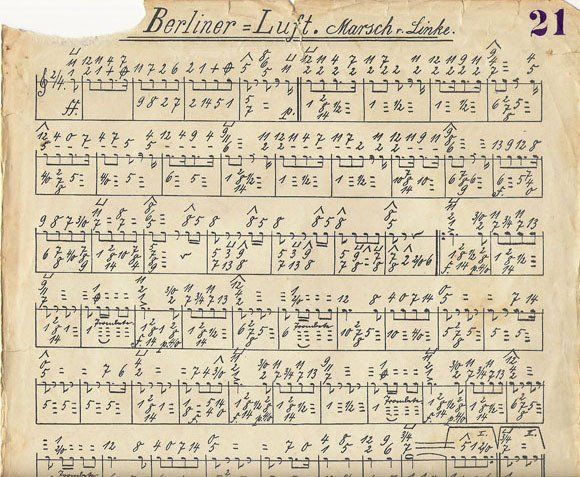
Slide title
Write your caption hereButton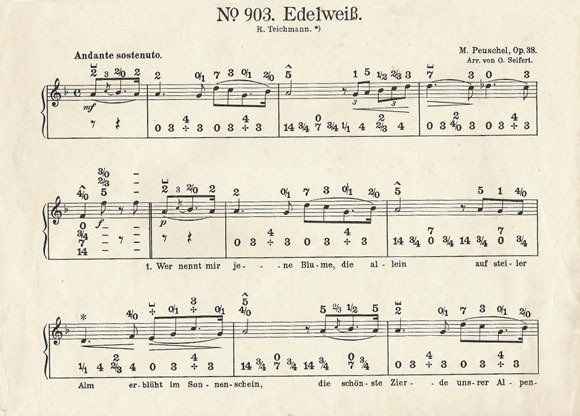
Slide title
Write your caption hereButton

In Germany a new notation system for bandoneons and concertinas was developed, the so called ”wash-line” notation (because it looks like clothes on a line). The reason was probably that many of the bandoneonists could not read ordinary sheet music. The system uses the numbers/symbols on each button, plus the symbols of bellows open and bellows close. It also uses whole, half, quarts etc. tones for timing. Another transitional system was also used, where the melody was written in ordinary notation and the accompaniment with numbers. To day the Germans use ordinary (piano) notation.

Belg og spilleposisjoner -
I motsetning til vanlig trekkspill, der belgen bare beveges av venstre arm, brukes begge armene på bandoneon og konsertina. Dette gjør belgen til en ekstra følsom og viktig del av instrument. Det er viktig å finne den mest hensiktsmessige belgføringen, bl.a. fordi de fleste tonene er på forskjellige knapper ved åpning og lukking. Instrumentet har et spesielt stort spjell, som gjør det mulig å tømme eller fylle belgen meget raskt. Bandoneonistene i Argentina og Uruguay fant tidlig ut at kvaliteten på ”åpningstonene” vare bedre enn på ”lukketonene”, så de spilte mye mer med åpningstoner.
Den vanlige spillestillingen er sittende, med instrumentet over begge, ev. ett av knærne. Instrumentene har ringer festet i belgrammene som gjør det mulig å hekte på en sele dersom man vil spille stående eller gående. Slike seler er ikke i bruk lengre.
I Argentinsk tango benyttes ofte en spesiell perkussiv effekt der instrumentet ligger over det ene kneet mens helen trampes i gulvet og belgen trekkes raskt utover. Det er også vanlig i tango å spille stående, men uten sele. Kneet bøyes og foten settes opp på en stol.

Bellows and playing positions
Contrary to the ordinary accordion, where only the left arm moves the bellows, both arms are used for bandoneon and concertina. This makes the bellows an important and sensitive part of the instrument. It is important to find the right bellows movements, also because most tones are not allocated to the same buttons for opening and closing. The instrument has an exceptionally big air valve that makes it possible to fill or evacuate the bellows very quickly. The bandoneonists of Argentina and Uruguay soon discovered that the quality of the opening tones was better than that of the closing tones, and therefore use opening tones much more.
The ordinary playing position is sitting, with the instrument across one or both knees. Rings in the bellow frames can be used to hook up a harness for playing standing up or walking. Such harness is not used anymore.
For Argentinean tango a special percussive effect is often used, where the instrument across one knee, while the foot is stamped to the floor and the bellows pulled. It is also quite common to play tango in the standing position, without harness but with one foot bent and up on a chair and the bandoneon across the knee.

Stemming
Et 142 eller 144-toners bandoneon kan spille nesten alle halvtoner fra kontra G til trestrøken a, både på åpning og lukking. Det er overlapp mellom de to sidene med vel én oktav. Bandoneoner med argentinsk system er alltid oktavstemt, dvs. at når en tone spilles klinger to tunger som er stemt akkurat en oktav forskjellig, 8’ (fot) for den laveste og 4’ for den høyeste. Betegnelsene er hentet fra kirkeorgelet der tallene står for lengden av de tilsvarende orgelpipene. Tyske bandoneoner kan enten være oktavstemte eller tremolostemte. Tremolostemming vil si at to tunger som klinger samtidig er stemt nesten likt, som gir en mer typisk trekkspillyd.
Den tonen som klinger på knapp nummer 2 når belgen åpnes på både bandoneon og konsertina angir instrumentets hovedtone. Denne er vanligvis enstrøken a. Det hender imidlertid at eldre tyske bandoneoner kan være stemt med en annen hovedtone. Grunnen til dette var nok at det skulle være lettere å spille sammen med andre instrumenter, for eksempel B-instrumenter, uten å måtte transponere. For å finne ut om et instrument er konsertina eller bandoneon kan man prøve knapp nr. 14. Dersom den klinger likt ved begge belgretninger dreier det seg om en konsertina.
Selve stemmingen er som på vanlig trekkspill- Hvis man ønsker en høyere tone files litt masse vekk fra tungespissen, mens en lavere tone oppnås ved å fjerne masse fra tungeroten, ev. legg til litt på spissen (lodd).

Tuning
A 142 or 144 tone bandoneon can play almost all semitones from contra G to three lined a, both on opening and closing of the bellows. The two sides of the instrument overlap with about one octave. Bandoneons with Argentinean tuning are always octave tuned, i.e. when one tone is played two reeds sound exactly one octave apart. 8’ (feet) and 4’. The feet-denominations are taken from the church organ where the numbers indicate the length in feet of the corresponding pipe. German bandoneons can be both octave and tremolo tuned. With tremolo tuning two reeds with almost the same tuning sing together, this gives a more typical accordion sound.
The sound from button no. 2 when the bellows open on both bandoneons and concertinas indicates how the instrument is tuned. It is usually a one-lined a, but older German bandoneons may have different basic tuning. The reason for this was probably to make it easier to play together with other instruments, e.g. Bb instruments, without having to transpose the music. To find whether an instrument is a concertina or a bandoneon try button no. 14. For concertinas the tone is the same for bellows out and bellows in.
The tuning process is like any accordion. If you want a sharper tone, you file away some mass from the reed tip, while filing on the reed root, or adding some mass at the tip (weights) give a flatter tone.
OAbandoneon website design and production by Steve Morrall © OABandoneon.com 2023
